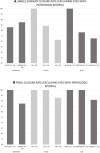Long-Term Outcomes of Macular Hole Repair with Triamcinolone Acetonide Visualization
- PMID: 33888976
- PMCID: PMC8057828
- DOI: 10.2147/OPTH.S303890
Long-Term Outcomes of Macular Hole Repair with Triamcinolone Acetonide Visualization
Abstract
Purpose: To evaluate the long-term anatomic and visual outcomes of macular hole (MH) repair utilizing triamcinolone acetonide (TA) visualization of the internal limiting membrane (ILM) treated at a tertiary care retina practice.
Methods: Retrospective chart review of eyes undergoing MH repair with ILM peel utilizing TA visualization followed by gas tamponade and facedown positioning between 2014 and 2020. Pre- and post-operative visual acuity (VA), IOP, and anatomic closure based on optical coherence tomography were documented.
Results: Seventy-eight eyes were followed for 2.3±0.2 years after primary repair with anatomic closure in 73 (94%) eyes at their final visit and excluding eyes with pathologic myopia, 97%, and for stage 2 and small MHs, 100%. In all eyes, VA significantly improved from 0.97±0.04 (Snellen: 20/187) to 0.66±0.06 (20/91) logMAR (p < 0.0001). There were 16 eyes with 4 years of follow-up, 10 (63%) eyes achieving a VA ≥20/30 at that follow-up visit. Stage 2 and 3 MHs had significantly greater improvements in VA than Stage 4 MHs, -0.46 ± 0.06 versus -0.11 ± 0.11 logMAR (p = 0.021). Of the 13 (17%) eyes with recurrent MHs, 6 (46%) had pathologic myopia and 8 (61.5%) had associated cystoid macular edema. Cataract progression was reported in 52 (96%) phakic eyes and 2 eyes required Ahmed valve placement for management of pre-existing glaucoma.
Conclusion: Long-term results of MH repair with TA for ILM visualization demonstrate that it is safe and effective. Visual acuity continued to improve throughout the follow-up. Pre-existing glaucoma may progress and recurrence is associated with pathologic myopia and macular edema.
Keywords: internal limiting membrane; macular hole; triamcinolone acetonide.
© 2021 Wallsh et al.
Conflict of interest statement
The authors report no conflicts of interest in this work.
Figures






Similar articles
-
Autologous Retinal Transplantation for Primary and Refractory Macular Holes and Macular Hole Retinal Detachments: The Global Consortium.Ophthalmology. 2021 May;128(5):672-685. doi: 10.1016/j.ophtha.2020.10.007. Epub 2020 Oct 10. Ophthalmology. 2021. PMID: 33045315
-
Does intravitreal triamcinolone acetonide-assisted peeling of the internal limiting membrane effect the outcome of macular hole surgery?Graefes Arch Clin Exp Ophthalmol. 2005 Aug;243(8):754-7. doi: 10.1007/s00417-005-1133-x. Epub 2005 Mar 3. Graefes Arch Clin Exp Ophthalmol. 2005. PMID: 15744526
-
Macular Hole Surgery Using Gas Tamponade-An Outcome from the Oslo Retrospective Cross-Sectional Study.J Clin Med. 2019 May 17;8(5):704. doi: 10.3390/jcm8050704. J Clin Med. 2019. PMID: 31108955 Free PMC article.
-
Anatomical and visual outcomes in high myopic macular hole (HM-MH) without retinal detachment: a review.Graefes Arch Clin Exp Ophthalmol. 2014 Feb;252(2):191-9. doi: 10.1007/s00417-013-2555-5. Epub 2014 Jan 3. Graefes Arch Clin Exp Ophthalmol. 2014. PMID: 24384802 Review.
-
Best surgical technique and outcomes for large macular holes: retrospective multicentre study in Japan.Acta Ophthalmol. 2018 Dec;96(8):e904-e910. doi: 10.1111/aos.13795. Epub 2018 Apr 19. Acta Ophthalmol. 2018. PMID: 29671948 Review.
Cited by
-
Treatment of Failure of Macular Hole Closure due to Post-Vitrectomy Macular Edema Using Sub-Tenon Triamcinolone Acetonide Injection: A Case Report.Case Rep Ophthalmol. 2024 Apr 12;15(1):326-334. doi: 10.1159/000538026. eCollection 2024 Jan-Dec. Case Rep Ophthalmol. 2024. PMID: 38618210 Free PMC article.
-
Minimal Gas Vitrectomy and As-Needed Positioning Duration for Idiopathic Macular Holes.Ophthalmol Ther. 2025 May;14(5):923-939. doi: 10.1007/s40123-025-01114-1. Epub 2025 Mar 14. Ophthalmol Ther. 2025. PMID: 40085367 Free PMC article.
References
LinkOut - more resources
Full Text Sources
Other Literature Sources

